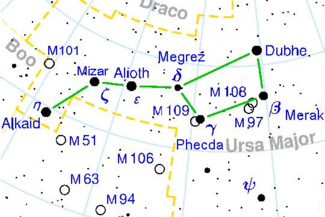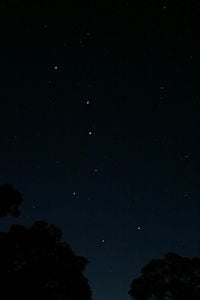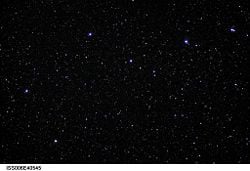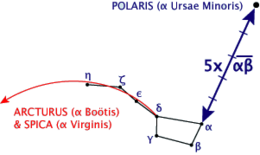Big Dipper
- This article is about the asterism.
In astronomy, the Big Dipper refers to an asterism that consists of the seven brightest stars of the constellation Ursa Major, or the Great Bear. This asterism has been recognized as a distinct grouping in many cultures from time immemorial, although it has been called by different names. The term Big Dipper is derived from the outline of the major stars, an outline that suggests the form of a large ladle or dipper.
The stars in the Big Dipper can be used as guides to finding other stars, such as Polaris (the North Star), Regulus in the constellation Leo, and Alphard in the constellation Hydra. In addition, the Big Dipper can be used to find certain galaxies, such as Messier 81 (M81) and Messier 82 (M82). On a practical level, the Big Dipper offers a guidepost for navigation by night.
Names and lore
North America

As noted above, this asterism is known as the Big Dipper because the major stars can be seen to follow the rough outline of a large ladle or dipper. This figuration appears to be derived originally from Africa, where it was sometimes seen as a drinking gourd. In the nineteenth century, runaway slaves would "follow the Drinking Gourd" to the north and freedom.
A widespread American Indian figuration had the bowl as a bear. Some groups considered the handle to be three cubs following their mother, while others pictured three hunters tracking the bear. (For example, see Abenaki mythology.) The Dipper appears on some Tribal flags.
Europe
In the British Isles this pattern is known as the Plough, although in Ireland the figure is sometimes called the Starry Plough and has been used as a political symbol. It is also occasionally referred to as the Butcher's Cleaver in northern England.
It was formerly called by the old name Charles' Wain ("wain" meaning "wagon," and derived from the still older Carlsw├Žn) as it still is in Scandinavia, Karlavagnen, Karlsvogna, or Karlsvognen. A folk etymology holds that it was named after Charlemagne, but this common Germanic name originally meant the men's wagon (the churls' wagon), in contrast to the women's wagon (the Little Dipper). Similarly, in Romanian and most Slavic languages it is known as "the Great Wagon," as opposed to "the Small Wagon," the Little Dipper. In German it is called Gro├čer Wagen (Great Cart). An older Odin's Wain may lie behind these northern concepts.
In Finland the figure is known as Otava and widely used as a cultural symbol. In Finnish dialects, the word otava means a "salmon net," but this word is largely obsolete in modern Finnish.
These seven stars ("Septentrio") are the origin of the Latin word septentriones meaning "north" and now found as the adjective septentrional (northern) in English, French, and Spanish.
Asia
In Hindu astronomy, it is referred to as (Vrihat) Sapta Rishi meaning "The Seven (Great) Sages."
Throughout eastern Asia, these stars compose the Northern Dipper. They are colloquially named "The Seven Stars of the Northern Dipper" (Chinese: ňľŚńŞâŠśč; pinyin: b─Ťidăĺu q─źx─źng; Japanese Romaji: hokuto shichisei; Korean: Hangul: ŰÂüŰĹÉý╣áýä▒, Romaja: Bukduchilseong; Vietnamese┬á: ch├▓m sao Bß║»c ─Éß║ęu). The seven stars are very important in Taoist astrology.
Sometimes there are said to be nine starsÔÇötwo invisible "attendant" stars, one on either side of the star Alkaid. These probably refer to two nearby Messier objects.
In Malaysia,it is known as Buruj Biduk (The Ladle).
An Arabian story has the four stars of the dipper's bowl as a coffin, with the three stars in the handle as mourners, following it.
Other
The Bible refers to it as "the seven stars" (Amos 5:8), though some translations have "Big Dipper" explicitly, and some translations of that verse refer to the Pleiades, which also has seven stars visible to the naked eye, instead.
In Tolkien's Middle-earth mythos, it is called the Sickle of the Valar, the sign of Hope signifying doom for Evil, while in T.A. Barron's Great Tree of Avalon series, it is called the Wizard's Staff, symbolizing Merlin's staff.
In the manga series, Fist of the North Star (Hokuto no Ken), the Hokuto in the original Japanese title refers not to the North Star in the official English title, but to the Big Dipper instead (Hokuto literally means Northern Dipper). The main character, Kenshiro, bears seven scars on his chests that forms the same shape as the Big Dipper. The Big Dipper itself or Hokuto Shichisei is a recurring symbolism in the series.
Stars
Within Ursa Major the stars of the Big Dipper have Bayer designations in consecutive Greek alphabetical order from the bowl to the handle.
| Proper Name |
Bayer Designation |
Apparent Magnitude |
Distance (L Yrs) |
|---|---|---|---|
|   Dubhe |     α UMa |       1.8 |    124 |
|   Merak |     β UMa |       2.4 |      79 |
|   Phecda |     γ UMa |       2.4 |      84 |
|   Megrez |     δ UMa |       3.3 |      81 |
| ┬á┬áAlioth | ┬á┬á┬á┬á╬Á UMa | ┬á ┬á ┬á 1.8 | ┬á ┬á ┬á81 |
| ┬á┬áMizar | ┬á┬á┬á┬á╬ UMa | ┬á ┬á ┬á 2.1 | ┬á ┬á ┬á78 |
| ┬á┬áAlkaid | ┬á┬á┬á┬á╬Ě UMa | ┬á ┬á ┬á 1.9 | ┬á ┬á 101 |
In the same line of sight as Mizar, but three light-years beyond it, is the star Alcor (80 UMa). Together they are known as the Horse and Rider. At fourth magnitude, Alcor would normally be relatively easy to see with the unaided eye, but its proximity to Mizar renders it more difficult to resolve, and it has served as a traditional test of sight. Mizar itself has four components and thus enjoys the distinction of being part of an optical binary as well as containing the first-discovered telescopic binary (1617) and the first-discovered spectroscopic binary (1889).
Five of the stars of the Big Dipper are at the core of the Ursa Major Moving Group. The two at the ends, Dubhe and Alkaid, are not part of the swarm, and are moving in the opposite direction. Relative to the central five, they are moving down and to the right in the map. This will slowly change the Dipper's shape, with the bowl opening up and the handle becoming more bent. In 50,000 years the Dipper will no longer exist as we know it, but be re-formed into a new Dipper facing the opposite way. The stars Alkaid to Phecda will then constitute the bowl, while Phecda, Merak, and Dubhe will be the handle.
Guidepost
Not only are the stars in the Big Dipper easily found themselves, they may also be used as guides to yet other stars:
- Polaris, the North Star, is found by imagining a line from Merak (╬▓) to Dubhe (╬▒) and then extending it for five times the distance between the two Pointers.
- Extending a line from Megrez (╬┤) to Phecda (╬│), on the inside of the bowl, leads to Regulus (╬▒ Leonis) and Alphard (╬▒ Hydrae). A mnemonic for this is "A hole in the bowl will leak on Leo."
- Crossing the top of the bowl from Megrez (╬┤) to Dubhe (╬▒) takes one in the direction of Capella (╬▒ Aurigae). A mnemonic for this is "Cap to Capella."
- Castor and Pollux (╬▒ and ╬▓ Geminorum) can be located by crossing the bottom of the bowl from Phecda (╬│) to Merak (╬▓) and continuing onward.
- By following the curve of the handle from Alioth (╬Á) to Mizar (╬Â) to Alkaid (╬Ě), one reaches Arcturus (╬▒ Bo├Âtis) and Spica (╬▒ Virginis). A mnemonic for this is "Arc to Arcturus then speed to Spica."
Additionally, the Dipper may be used as a guide to telescopic objects:
- The approximate location of the Hubble Deep Field can be found by following a line from Phecda (╬│) to Megrez (╬┤) and continuing on for the same distance again.
- Crossing the bowl diagonally from Phecda (╬│) to Dubhe (╬▒) and proceeding onward for a similar stretch leads to the bright galaxy pair M81 and M82.
- Two spectacular spiral galaxies flank Alkaid (╬Ě), the Pinwheel (M101). to the north, and the Whirlpool (M51), to the south.
See also
ReferencesISBN links support NWE through referral fees
- Dickinson, Terence, and Alan Dyer. 2008. The Backyard Astronomer's Guide. Richmond Hill, Ont: Firefly Books. ISBN 978-1554073443.
- Raymond, John C. 2005. Asterisms for Small Telescopes and Binoculars. Lawrenceville, VA: Brunswick Pub. ISBN 978-1556182051.
- Seronik, Gary. 2006. Binocular Highlights: 99 Celestial Sights for Binocular Users. Cambridge, MA: New Track Media. ISBN 978-1931559430.
- Sinnott, Roger W. 2006. Sky & Telescope's Pocket Sky Atlas. Cambridge, MA: Sky Pub. ISBN 978-1931559317.
Credits
New World Encyclopedia writers and editors rewrote and completed the Wikipedia article in accordance with New World Encyclopedia standards. This article abides by terms of the Creative Commons CC-by-sa 3.0 License (CC-by-sa), which may be used and disseminated with proper attribution. Credit is due under the terms of this license that can reference both the New World Encyclopedia contributors and the selfless volunteer contributors of the Wikimedia Foundation. To cite this article click here for a list of acceptable citing formats.The history of earlier contributions by wikipedians is accessible to researchers here:
The history of this article since it was imported to New World Encyclopedia:
Note: Some restrictions may apply to use of individual images which are separately licensed.



